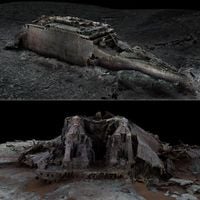In a groundbreaking achievement for maritime archaeology, deep-sea mapping company Magellan, in collaboration with Atlantic Productions, has created the first-ever full-sized 3D digital scan of the RMS Titanic. This monumental project, detailed in the National Geographic documentary titled Titanic: The Digital Resurrection, offers an unprecedented view of the shipwreck and the debris surrounding it, allowing researchers to explore this tragic site in ways never before possible.
The Titanic, which sank on April 14, 1912, lies approximately 3,800 meters beneath the Atlantic Ocean, about 370 nautical miles off the coast of Newfoundland. The ship, measuring 883 feet in length, was carrying over 2,200 passengers and crew when it struck an iceberg, resulting in the loss of more than 1,500 lives. Only about 700 individuals were rescued.
Using two remote-controlled submersibles, the team spent six weeks meticulously capturing over 715,000 high-resolution images and 4K videos, amassing a staggering 16 terabytes of data. This extensive collection has been transformed into what Anthony Geffen, head of Atlantic Productions, describes as a "one-to-one digital copy, a 'twin,' of the Titanic in every detail." The resulting digital scan provides a clear picture of the entire ship, including both the front and back sections that are split by about 600 to 800 meters, as well as the three-mile debris field scattered around the wreck.
Unlike previous explorations that relied on submersibles to capture limited snapshots of the wreck, this innovative approach allows for a comprehensive examination of the Titanic and its surroundings. The digital twin not only reveals the ship's physical state but also serves as a vital tool for researchers investigating the circumstances of the disaster.
Among the findings from the scan, a broken porthole suggests that ice entered the cabins when the ship collided with the iceberg, corroborating accounts from survivors. Additionally, bent boilers and an open steam valve indicate that the engineers, led by Joseph Bell, worked tirelessly to maintain power and keep the lights on until the last moments, aiding in the evacuation efforts.
Furthermore, the digital reconstruction provides crucial insights into the actions of the crew during the disaster. For instance, the location of a lifeboat holder supports the narrative that First Officer William Murdoch was washed away while attempting to launch a lifeboat, countering claims that he abandoned his post.
Parks Stephenson, a Titanic analyst, emphasized the significance of this comprehensive mapping project, stating, "The Titanic is the last surviving eyewitness to the disaster, and she still has stories to tell. It’s like a crime scene: you need to see what the evidence is, in the context of where it is. Having a comprehensive view of the entirety of the wreck site is key to understanding what happened here." This perspective underscores the importance of the digital twin in piecing together the events of that fateful night.
The documentary Titanic: The Digital Resurrection, which chronicles the monumental task of capturing the footage and creating this never-before-seen view of the iconic wreck, was released on April 11, 2025, and is now available for streaming on Disney+ and Hulu. The film captures nearly two years of research conducted by historians, scientists, and engineers, all aimed at reviewing and challenging long-held assumptions about the Titanic's final moments.
As the world continues to reflect on the legacy of the Titanic, this new digital reconstruction represents a significant advancement in our understanding of maritime history. By providing a detailed, immersive experience of the wreck site, researchers hope to uncover new insights into the tragedy and honor the memory of those who lost their lives.
The digital twin of the Titanic not only serves as a remarkable technological achievement but also as a poignant reminder of the human stories intertwined with this maritime disaster. As more people engage with the documentary and the findings from the scan, the hope is that the lessons learned from the Titanic will continue to resonate and inform future maritime safety practices.


